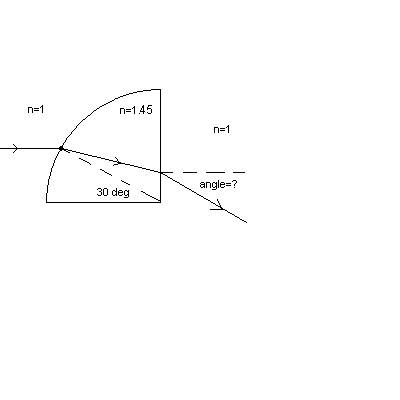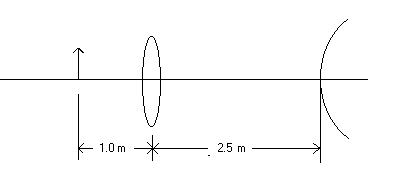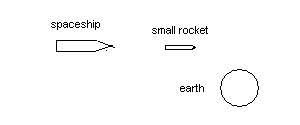
|
Test 3 Sp 2001 |
1.
(30 points) A glass-like material having an index of refraction n = 1.45 is surrounded by a vacuum and is in the shape of a quarter circle. A light ray parallel to the horizontal base of the material is incident from the left at the point shown. At that point, the radial line from the center to the point makes an angle of 30-degrees with the horizontal. The ray travels through the material and exits on the right vertical side as shown. What is the angle the exiting ray makes with the horizontal normal?

2. (34 points)
An upright image stands 1.0 m in front of a converging lens of focal length of magnitude | f1 |= 0.50 m. The lens is 2.5 m from a convex mirror of focal length of magnitude | f2 | = 0.50 m. See the diagram below. Assume that the light goes through the lens, reflects off the mirror and forms a final image without going through the lens again. (In other words, make the simple assumption that the light goes through the lens only once.)

3. (20 points) A thin film of cryolite (n = 1.35) of thickness d is applied to thick layer of oil (n = 1.25). See the diagram below. Assume the incident light has wavelength 575 nm and is normal to the air-cryolite interface.

4. (20 points)
(a) (10 points) A binary system in the constellation Orion has an interstellar separation of 1.00x10-5 radians. (This is the angle between the 2 rays from the 2 stars received by the detecting telescope.) If the wavelength of the light is 500 nm, what is the smallest diameter D a telescope must have to just resolve the two stars?
(b) (10 points) Assume that the two stars are located a distance 1.50 x1011 m from each other. How far is the binary star system from the telescope?
5. Extra Credit (8 points)
A spaceship travels at 0.700c relative to the earth.
(a) (4 points) The spaceship fires a small rocket in the forward direction. How fast relative to the ship must the small rocket be fired in order for the rocket to travel at 0.900c relative to the earth? See the diagram below.
(b) (4 points) Assume that the small rocket has a length 300 m as measured by a passenger on the small rocket. How long does it take the small rocket to pass the earth as measured by an observer on the earth? See the diagram below.
